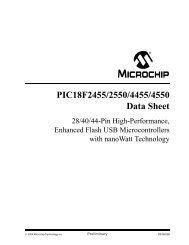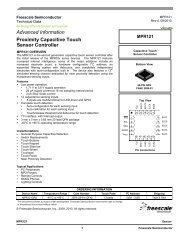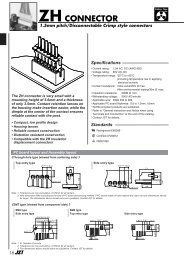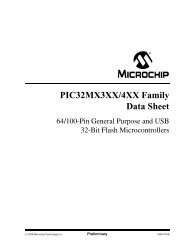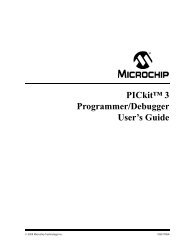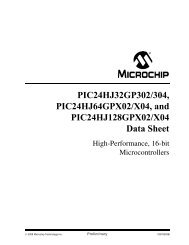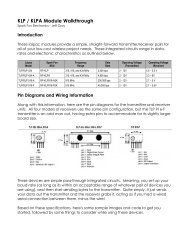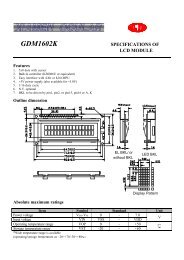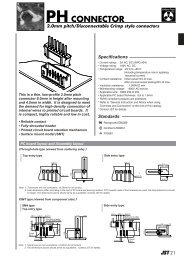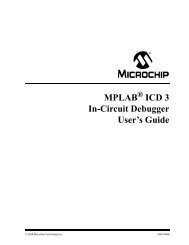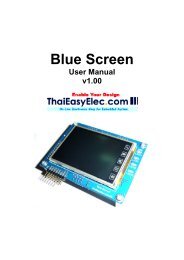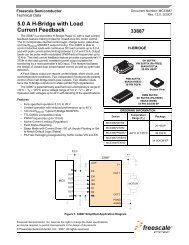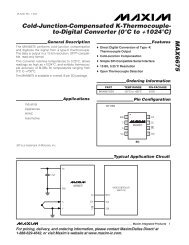SC16IS740/750/760 Single UART with I2C-bus/SPI interface, 64 ...
SC16IS740/750/760 Single UART with I2C-bus/SPI interface, 64 ...
SC16IS740/750/760 Single UART with I2C-bus/SPI interface, 64 ...
Create successful ePaper yourself
Turn your PDF publications into a flip-book with our unique Google optimized e-Paper software.
NXP Semiconductors<br />
<strong>SC16IS740</strong>/<strong>750</strong>/<strong>760</strong><br />
<strong>Single</strong> <strong>UART</strong> <strong>with</strong> I 2 C-<strong>bus</strong>/<strong>SPI</strong> <strong>interface</strong>, <strong>64</strong>-byte FIFOs, IrDA SIR<br />
10. I 2 C-<strong>bus</strong> operation<br />
The two lines of the I 2 C-<strong>bus</strong> are a serial data line (SDA) and a serial clock line (SCL). Both<br />
lines are connected to a positive supply via a pull-up resistor, and remain HIGH when the<br />
<strong>bus</strong> is not <strong>bus</strong>y. Each device is recognized by a unique address whether it is a<br />
microcomputer, LCD driver, memory or keyboard <strong>interface</strong> and can operate as either a<br />
transmitter or receiver, depending on the function of the device. A device generating a<br />
message or data is a transmitter, and a device receiving the message or data is a<br />
receiver. Obviously, a passive function like an LCD driver could only be a receiver, while a<br />
microcontroller or a memory can both transmit and receive data.<br />
10.1 Data transfers<br />
One data bit is transferred during each clock pulse (see Figure 16). The data on the SDA<br />
line must remain stable during the HIGH period of the clock pulse in order to be valid.<br />
Changes in the data line at this time will be interpreted as control signals. A HIGH-to-LOW<br />
transition of the data line (SDA) while the clock signal (SCL) is HIGH indicates a START<br />
condition, and a LOW-to-HIGH transition of the SDA while SCL is HIGH defines a STOP<br />
condition (see Figure 17). The <strong>bus</strong> is considered to be <strong>bus</strong>y after the START condition and<br />
free again at a certain time interval after the STOP condition. The START and STOP<br />
conditions are always generated by the master.<br />
SDA<br />
SCL<br />
data line<br />
stable;<br />
data valid<br />
change<br />
of data<br />
allowed<br />
mba607<br />
Fig 16.<br />
Bit transfer on the I 2 C-<strong>bus</strong><br />
SDA<br />
SDA<br />
SCL<br />
S<br />
P<br />
SCL<br />
START condition<br />
STOP condition<br />
mba608<br />
Fig 17.<br />
START and STOP conditions<br />
The number of data bytes transferred between the START and STOP condition from<br />
transmitter to receiver is not limited. Each byte, which must be eight bits long, is<br />
transferred serially <strong>with</strong> the most significant bit first, and is followed by an acknowledge bit<br />
(see Figure 18). The clock pulse related to the acknowledge bit is generated by the<br />
master. The device that acknowledges has to pull down the SDA line during the<br />
acknowledge clock pulse, while the transmitting device releases this pulse (see<br />
Figure 19).<br />
<strong>SC16IS740</strong>_<strong>750</strong>_<strong>760</strong>_6<br />
© NXP B.V. 2008. All rights reserved.<br />
Product data sheet Rev. 06 — 13 May 2008 37 of 62



